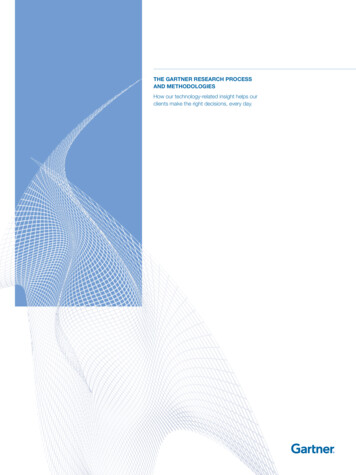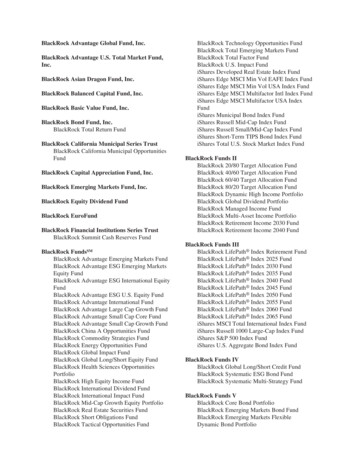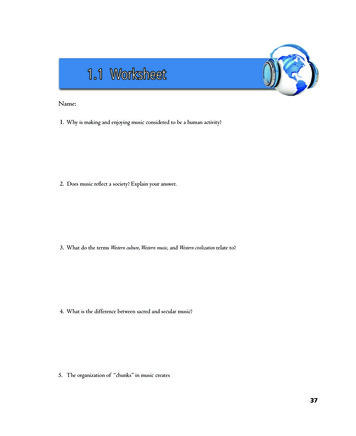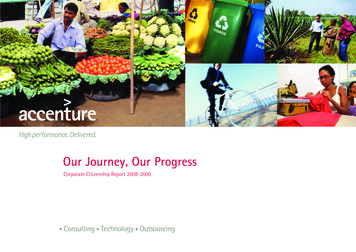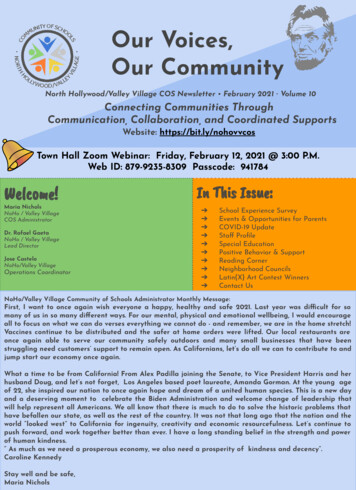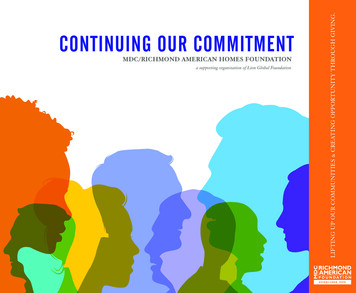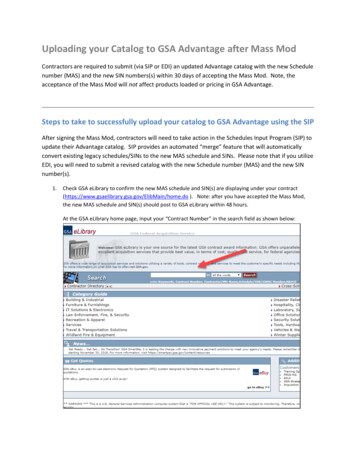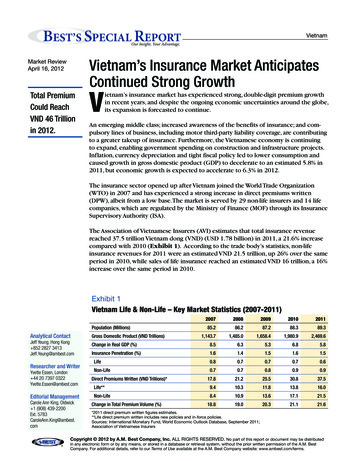
Transcription
BEST’S SPECIAL REPORTVietnamOur Insight, Your Advantage.Vietnam’s Insurance Market AnticipatesContinued Strong GrowthMarket ReviewApril 16, 2012Total PremiumCould ReachVND 46 Trillionin 2012.Vietnam’s insurance market has experienced strong, double-digit premium growthin recent years, and despite the ongoing economic uncertainties around the globe,its expansion is forecasted to continue.An emerging middle class; increased awareness of the benefits of insurance; and compulsory lines of business, including motor third-party liability coverage, are contributingto a greater takeup of insurance. Furthermore, the Vietnamese economy is continuingto expand, enabling government spending on construction and infrastructure projects.Inflation, currency depreciation and tight fiscal policy led to lower consumption andcaused growth in gross domestic product (GDP) to decelerate to an estimated 5.8% in2011, but economic growth is expected to accelerate to 6.3% in 2012.The insurance sector opened up after Vietnam joined the World Trade Organization(WTO) in 2007 and has experienced a strong increase in direct premiums written(DPW), albeit from a low base.The market is served by 29 non-life insurers and 14 lifecompanies, which are regulated by the Ministry of Finance (MOF) through its InsuranceSupervisory Authority (ISA).The Association of Vietnamese Insurers (AVI) estimates that total insurance revenuereached 37.5 trillion Vietnam dong (VND) (USD 1.78 billion) in 2011, a 21.6% increasecompared with 2010 (Exhibit 1). According to the trade body’s statistics, non-lifeinsurance revenues for 2011 were an estimated VND 21.5 trillion, up 26% over the sameperiod in 2010, while sales of life insurance reached an estimated VND 16 trillion, a 16%increase over the same period in 2010.Exhibit 1Vietnam Life & Non-Life – Key Market Statistics (2007-2011)Population (Millions)Analytical ContactJeff Yeung, Hong Kong 852 2827 3413Jeff.Yeung@ambest.comResearcher and WriterYvette Essen, London 44 20 7397 0322Yvette.Essen@ambest.comEditorial ManagementCarole Ann King, Oldwick 1 (908) 439-2200Ext. 5783CaroleAnn.King@ambest.comGross Domestic Product (VND 1,143.71,485.01,658.41,980.92,469.6Change in Real GDP (%)8.56.35.36.85.8Insurance Penetration 70.80.90.917.821.225.530.837.5Direct Premiums Written (VND 913.617.121.518.819.020.321.121.6Change in Total Premium Volume (%)*2011 direct premium written figures estimates.**Life direct premium written includes new policies and in-force policies.Sources: International Monetary Fund, World Economic Outlook Database, September 2011;Association of Vietnamese InsurersCopyright 2012 by A.M. Best Company, Inc. ALL RIGHTS RESERVED. No part of this report or document may be distributedin any electronic form or by any means, or stored in a database or retrieval system, without the prior written permission of the A.M. BestCompany. For additional details, refer to our Terms of Use available at the A.M. Best Company website: www.ambest.com/terms.
Special ReportVietnam Market ReviewWhile the demand for insurance is showing strong growth, insurance premium as apercentage of GDP remains static at around 1.5% (see Exhibit 1). At the beginning of2012, Phung Dac Loc, General Secretary of the AVI, predicted the insurance sector has thepotential to expand further as the economy experiences faster growth. He forecasted thatnon-life insurance would increase at about 28% in 2012, with direct premiums totallingVND 27.5 trillion. Life insurance is expected to grow by 18%, with direct premiums climbing to VND 18.9 trillion in 2012.Should the market grow at the pace predicted by the AVI, total premiums for the industrywould reach VND 46.4 trillion, up 24% from 2011.The AVI is not alone in its projections ofcontinuing strong demand for insurance.Trinh Thanh Hoan, director of the ISA, has beenquoted in the media as predicting that total premiums could reach VND 43 trillion in 2012.However, he warned that companies need to adapt to the competitive insurance market.To tap market potential, he advised insurers to focus on attracting high-quality humanresources, develop new products, expand distribution networks and concentrate onmicroinsurance products (see special report The Potential of Microinsurance, March 5,2012).Although agents remain the key sales channel for personal lines and life products, insurers are developing alternative distribution routes, such as bancassurance, and enhancingonline sales platforms. Liberty Insurance (Vietnam) Ltd. claims to be the first insurer inthe country to operate an online automobile insurance distribution channel. Furthermore,in August 2011, BIDV Insurance Corp. (BIC) launched a website and online paymentsettlement system for high-income customers, offering automobile, motorcycle, accident,property and travel insurance.Diverse Challenges Face InsurersWhile the insurance market is showing strong growth, Vietnam’s economic challengescontinue to create uncertainty for insurers. Vietnam remains the sole Southeast Asiancountry to fall into A.M. Best’s CRT-5 (Country Risk Tier 5) category – the highest tier –for countries considered to present the most risk. In comparison, Singapore is assignedto CRT-1 (Country Risk Tier 1), which denotes a stable environment with the lowestproportion of risk.The Philippines and Indonesia are classed as CRT-4 countries, whileMalaysia and Thailand fall into the CRT-3 category. (See A.M. Best’s criteria report Assessing Country Risk, May 23, 2011.)Agricultural Risks and Insurance AffordabilityDespite the strong growth of the Vietnameseinsurance sector, affordability remains a majorchallenge. Microinsurance therefore representsa way of accessing the lower economic segments ofthe market.inces piloting agricultural insurance.Several companies have been approved to offeragricultural insurance on a nonprofit principle from2011 to 2013.The state will pay 100% of premiumsfor poor farming households and individuals participating in the agricultural insurance pilot plan. Governmental support will drop to 80% of premiums forsubpoor farming households and individuals, and to60% of premium for “normal” participating farminghouseholds and individuals. For farming organisations, there will be a 20% government subsidy.The Vietnamese government has begun rolling out apilot insurance plan to protect farmers from lossescaused by natural disasters and epidemics affectingcrops and animals. In October 2011, the Ministry ofFinance called for the establishment of local steeringcommittees to guide local operations in the prov2
Special ReportVietnam Market ReviewVND TrillionsExhibit 2Vietnam Non-Life – Aggregated Combined Ratio & Premiums,4 Largest Insurers* 0%40%20%200720092008 Net Operating Expenses Net Premiums Written Earned Premiums— Combined Ratio0%2010 Net Claims Incurred*Baoviet, PVI, Bao Minh and PJICOSource: A.M. Best Co.Vietnam has high levels of economic and political risk and even higher financial systemrisk. Inflation in particular remains a serious concern, eroding consumer spending andincreasing compensation costs. Inflation reached 18.8% in 2011, largely from higherfood and fuel prices, and is projected to moderate only somewhat in 2012 to a still high12.1%.In the past few years, there has been considerable uncertainty over Vietnam’s economic policy. A.M. Best expects difficult economic conditions over the next few yearsto create a challenging environment for economic reform.While Vietnam’s pegged exchange rate restricts monetary policy, the country canadjust the peg to absorb pressure on its currency. Vietnam’s current account deficithas narrowed considerably in recent years but has not reduced pressure on the foreignexchange. In 2011, the dong was devalued by 9.3% against the U.S. dollar, and the trading band was narrowed from 3% to 1%. The dong is expected to continue slightlydepreciating against the U.S. dollar in 2012.VND TrillionsExhibit 3Vietnam – Direct Premiums Written* 92010*2011 DPW is estimated.Source: Association of Vietnamese Insurers32011
Special ReportVietnam Market ReviewConsiderable economic uncertainty has made the stock market volatile. In2011, the Vietnam Ho Chi Minh Stock Index (VN-Index) fell 28%, although ithas bounced back in 2012, recovering 30.5% for the year through March 26.In addition to economic challenges, insurance rates are under pressure fromthe competitive market environment. Nevertheless, some insurers are attempting to improve pricing and terms and conditions. Samsung Vina Insurance Ltd.(SVI), with a Best's Financial Strength Rating (FSR) of B , posted a decreasein its overall loss ratio between 2006 and 2010 due to tightened underwritingguidelines and a larger retained premium base. The insurer, owned by SamsungFire & Marine Insurance Co. and Vietnam National Reinsurance Corp.(Vina Re),has been more selective in accepting risks, thereby improving claims experience in its marine, property and personal lines over the past five years.Exhibit 2 shows the four largest non-life insurers have posted improved combined ratios in recent years. Baoviet Holdings (Baoviet), Petrovietnam Insurance Joint Stock Corp. (PVI), Bao Minh and Petrolimex Joint-Stock InsuranceCo. (PJICO) together controlled 66% of the country’s non-life insurance market in 2010. In 2007, their aggregate combined ratio stood at 115%, but fellto 88.9% in 2010. Both expenses and claims ratios declined during these fouryears, while net premiums written (NPW) increased strongly.Still, companies have faced legal challenges when they have attempted toincrease rates. In 2010, 19 insurance companies were fined for colluding toForeign Participation in the Vietnamese Insurance MarketForeign insurers are being drawn to Vietnam’sinsurance market as the country’s populationexpands, reaching an estimated 89 million in2011, and more of its people emerge from povertyas the economy grows.Several international insurers have whollyowned foreign subsidiaries in the country. Theseinclude Taiwan’s Cathay Financial Group, represented by Cathay Insurance (Vietnam) Co., andJapan’s Mitsui Sumitomo Insurance Co., whichowns MSIG Insurance (Vietnam) Co. LibertyMutual Group opened its first representativeoffice in Hanoi in 2003 and three years later wasawarded a licence to operate a wholly U.S.-ownedgeneral insurer in the country. In April 2011, Italy’sGenerali received a licence to start a whollyowned subsidiary, Generali Vietnam Life InsuranceCo.As cited earlier (see section “Fundraisings on theAgenda”), in the past few years, some of the largerdomestic insurers such as Petrovietnam InsuranceJoint Stock Corp. (PVI) have attracted foreign strategic shareholders. Exhibit 4 shows some keyExhibit 4investments in Vietnamese (re)insurers by overForeign Participation in Vietnamese Insurers seas financial companies.Vietnamese InsurerForeign Strategic Partner(s)Baoviet HoldingsHSBC Insurance (Asia Pacific)Holdings Ltd.Petrovietnam Insurance JointStock Corp. (PVI)Oman Investment Fund, TalanxGroupBao Minh Insurance Joint StockCorp.Axa GroupVietnam National ReinsuranceCorp. (Vina Re)Swiss ReIn 2011, PVI attracted a second overseas partner– Talanx Group, Germany’s third-largest insurerwhich is investing in the company through itssubsidiary HDI-Gerling.Talanx joined the OmanInvestment Fund as an investor. At the ceremonymarking the Talanx partnership in November 2011,PVI said in a press release this was “a significantmove to promote PVI as an international brand.”(continued)Source: A.M. Best Co. research4
Special ReportVietnam Market Reviewraise motor premiums in 2008. Furthermore, some insurers now face accusations that they have colluded to increase premiums collected from school students.Fundraisings on the AgendaThe anticipated wave of fundraisings in the Vietnamese insurance market, aspredicted in A.M. Best’s June 2011 special report Vietnam’s Insurance Market Awakening to Further Change, was a dominant trend in the second halfof the year. A.M. Best predicted insurers would access the stock markets asregulatory requirements were changing, while companies were needing toincrease capital to support the underwriting of more new business. Exhibit3 shows DPW has increased significantly in recent years. In July 2011, PJICObegan trading on the Ho Chi Minh Stock Exchange, while BIC gained approvalto deposit 66 million shares the same month.In October, HDI-Gerling Industrie Versicherung AG (HDI-Gerling) receivedapproval from the Vietnamese regulator to acquire new shares issued by PVIHoldings for a total of VND 1,916.5 billion. HDI-Gerling took a 25% shareholding in the company and agreed to provide technical support and reinsurancecapacity to its affiliates (see sidebar, “Foreign Participation in the VietnameseInsurance Market”). Part of the capital raised (VND 700 billion) strengthenedPVI’s risk-based capitalization and supported its ongoing business expansion.PVI Insurance, the second-largest non-life market participant in Vietnam, has aBest's Financial Strength Rating (FSR) of B .(Foreign Participation continued)International insurers can provide expertise inareas such as corporate governance, technology,training, product and distribution, as well as staffmanagement positions. Baoviet Holdings statedin its 2010 annual report that “with the supportand strategic and technical expertise of HSBC,”it has invested in projects including the establishment of a modern and transparent corporategovernance system. HSBC Insurance (Asia Pacific)Holdings Ltd., which first took a stake in Baovietin 2007, works with the insurer in areas such asrisk management, information technology andbancassurance.not immediately reap significant returns from theirinvestments in domestic companies. For example,market participants note that the operating environment remains competitive, and while the VNIndex has recovered some of 2011’s losses, it is farfrom buoyant and remains below half its level offive years ago.Foreign insurers also have been entering Vietnam’sinsurance market through operating joint ventures.Samsung-Vina Insurance Co.’s origins date back to1995 as a representative office of Samsung Fire &Marine Insurance Co. (SFM). In 2002, SFM receivedapproval from the MOF to establish a joint venturewith Vina Re. The Korea-Vietnam joint venture isowned equally by both shareholders.Meanwhile Swiss Re, which in 2008 bought a 25%stake in Vietnam National Reinsurance Corp. (VinaRe), works with the domestic reinsurer to offeragricultural products.In October 2011, Aviva Corporation, in a new jointventure with Vietnam Bank for Industry and Trade(VietinBank), launched VietinBankAviva Life Insurance Co. Ltd., which has VND 800 billion in chartercapital and will sell life and health products andservices. In the same month, Japan’s Sumitomo LifeInsurance Co. was licenced to open a representative office in Vietnam.All foreign investment in insurance companiesmust be approved by the Ministry of Finance(MOF). To date, the larger Vietnamese companieshave been the favourites of foreign investors, andother, smaller insurers are also said to be seekingoverseas partners. However, foreign insurers may5
Special ReportVietnam Market ReviewFurther Regulatory Change AnticipatedVietnam’s insurance sector is experiencing significant regulatory change.The amendedLaw on Insurance Business, effective July 1, 2011, aims to align the current insurance legislation more closely with international practices and to codify some of Vietnam’s commitments made before the country’s accession to the WTO.Following the Law on Insurance Business, in December 2011, Decree 123/2011/ND-CPwas issued. The decree, effective Feb. 15, 2012, covers the provision of cross-borderinsurance services, establishment and operation of foreign insurance branches in Vietnam and legal capital requirements.The law also sets out a bidding process for statebacked projects.In addition, the government and the MOF have issued a range of regulations, circulars and guidelines to promote insurance into new sectors. Lines of business featuredinclude compulsory fire and explosion insurance.It has recently been reported that the MOF is planning to further restructure the insurance sector, classifying Vietnam insurers into four groups.This is said to be part of amuch larger restructuring process of the financial sector to take place over the nextthree years. Under the plans, companies may be divided into categories, as follows: Group 1: Insurers with good liquidity and profitable business. These companies willbe permitted to expand their operations when supported by efficient business plans.They will be closely inspected and supervised going forward. Group 2: Insurance companies that meet prescribed solvency ratios but face challenges such as high operational costs or failure to post an operating profit in the pasttwo consecutive years.The regulator will evaluate these insurers’ operational efficiencies. Group 3: Companies that appear unlikely to meet minimum solvency levels. The regulator will assess these insurers and may, for instance, require them to restructure theirinvestments or transfer some policies to another insurer. Group 4: Insurance companies that are insolvent will be placed under special control. These could be forced to merge with other companies or else go into receivership.Exhibit 5Vietnam Non-Life — Retention Ratios, 4 Largest Insurers* (2007-2010)1465%VND Trillions121063%8661%59%457%202007 Gross Premiums Written2008 Net Premiums Written*Baoviet, PVI, Bao Minh and PJICOSource: A.M. Best Co.62009— Retention Ratio201055%
Special ReportVietnam Market ReviewWhile the Vietnamese government has formulated an insurance market developmentstrategy for high growth in the coming years, the restructuring plan aims to create anenvironment for insurance companies to focus on healthy growth, such as setting profitability and capital adequacy as key business objectives, and strengthening risk management practices and transparency of information.The speed of insurance companies’ consolidation in the coming years as a consequenceof the restructuring plan has not been projected. Nonetheless, A.M. Best believes theregulatory changes will lead to stronger insurers, as well as structured governance ofthe insurance sector, which will ultimately benefit insurance consumers.Natural Catastrophes Drive Reinsurance DemandRules stipulating that insurers were obliged to transfer at least 20% of certain risks toVina Re were removed in 2008. A number of companies in Vietnam have been lifting retention ratios in recent years. Exhibit 5 shows the four largest non-life insurersretained an aggregate of 59% of total risks in 2007. In the subsequent three years (2008to 2010), this level stabilised at approximately 65%.While retention ratios have risen, natural catastrophes in the region have resulted in acontinued heavy reliance on reinsurance support to protect capital bases against sizable losses. Vietnam is exposed to earthquake risk in the northern region, while floodsand typhoons are the primary risks in the central and southern regions. Natural catastrophes continue to be among the most significant risks facing Vietnam. Persistentflooding in the Mekong River Delta in September and October 2011 through sevenprovinces resulted in total estimated economic losses of USD 135 million. According tothe General Statistics Office of Vietnam, in 2011, natural catastrophes resulted in 257persons killed or reported missing, 267 persons injured, nearly 1,200 houses collapsedand swept away, and 391,800 houses damaged.Exposure to typhoon-related risks is among the largest concerns for insurers. Consequently, companies such as PVI and SVI control exposures to sizeable
Apr 16, 2012 · in August 2011, BIDV Insurance Corp. (BIC) launched a website and online payment settlement system for high-income customers, offering automobile, motorcycle, accident, property and travel insurance. Diverse Challenges Face Insurers While the insurance marke
